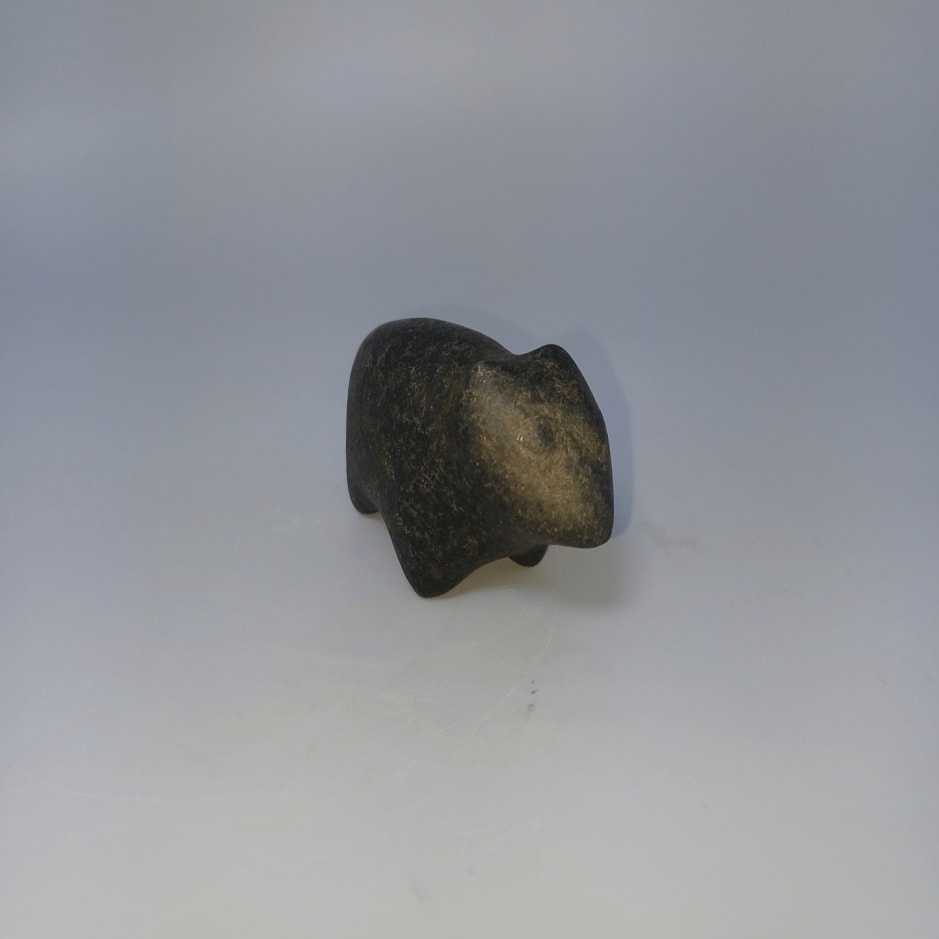Predynastic Egyptian Quadruped, possibly a Cow , 5000 BC - 3500 BC
Basalt
5.2 x 3 x 9 cm
2 x 1 1/8 x 3 1/2 in
2 x 1 1/8 x 3 1/2 in
CC.33
This enigmatic quadruped comes from the earliest period of Egyptian history, before the Pharaohs. It is of a simplistic design: four short triangular legs are carved from the large, roughly...
This enigmatic quadruped comes from the earliest period of Egyptian history, before the Pharaohs. It is of a simplistic design: four short triangular legs are carved from the large, roughly ovoid body, with a teardrop-shaped head. Some finer detail is apparent, with a protrusion representing the tail, and rudimentary ears and eyes. It is unclear what this quadruped is intended to represent, but given the importance of cattle in the Predynastic and the proportions of the piece (and the possibility that the ‘ears’ represent horns) it is conceivable that the artist aimed to create a cow or bull. Of course, it is possible that this figure was not meant to represent a living creature at all, and instead came entirely from the artist’s imagination.
While the form is simplistic, the talent of the artist is clear. Through abstract shapes, the artist creates the clear impression of a large quadruped creature. The unforgivingly hard basalt must have required a good deal of technical skill to create such smooth and provocative forms. The result is a thoroughly modern-looking piece, calling to mind the stylised forms of early Jeff Koons.
The purpose of this object is unclear, but the difficulty of carving basalt suggests that it was important in the life of the community, requiring a significant investment of time and energy to create. The most obvious use, then, is ritual. If indeed this object represents a bovine, then it comes at the start of a long tradition of cow-goddesses in Egyptian myth and religion. These goddesses, most notably Hathor, are especially related to maternity. Perhaps this image was a token for the protection of mother and child. Alternatively, the agricultural use of cattle must not be overlooked; this figure could have helped to ensure the fertility and safety of the herds. The importance of cattle to Predynastic cultures is emphasised by the number of cattle burials found at Predynastic sites, both interred with humans and on their own.
While the form is simplistic, the talent of the artist is clear. Through abstract shapes, the artist creates the clear impression of a large quadruped creature. The unforgivingly hard basalt must have required a good deal of technical skill to create such smooth and provocative forms. The result is a thoroughly modern-looking piece, calling to mind the stylised forms of early Jeff Koons.
The purpose of this object is unclear, but the difficulty of carving basalt suggests that it was important in the life of the community, requiring a significant investment of time and energy to create. The most obvious use, then, is ritual. If indeed this object represents a bovine, then it comes at the start of a long tradition of cow-goddesses in Egyptian myth and religion. These goddesses, most notably Hathor, are especially related to maternity. Perhaps this image was a token for the protection of mother and child. Alternatively, the agricultural use of cattle must not be overlooked; this figure could have helped to ensure the fertility and safety of the herds. The importance of cattle to Predynastic cultures is emphasised by the number of cattle burials found at Predynastic sites, both interred with humans and on their own.
